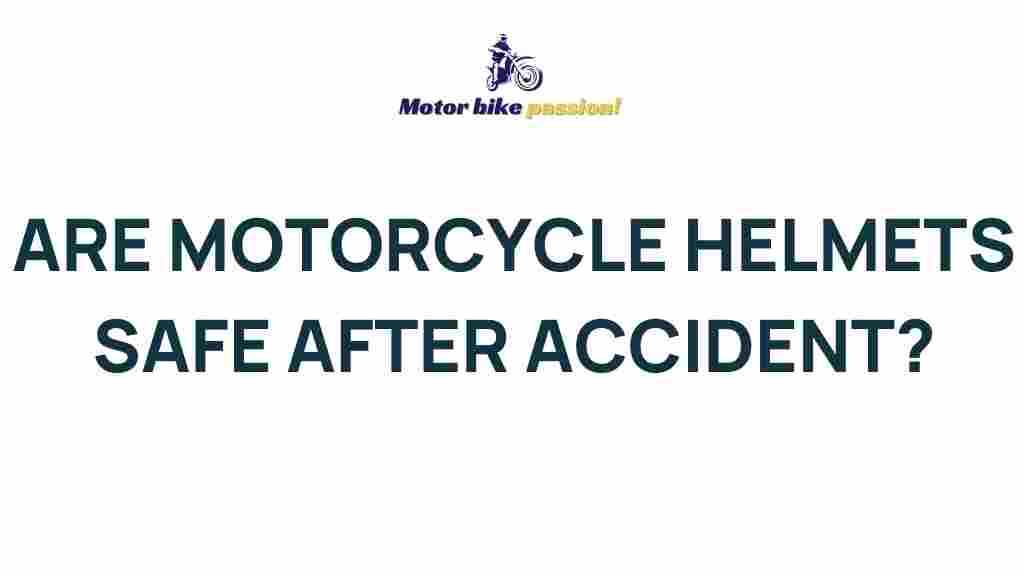Unveiling the Truth: Motorcycle Helmet Safety Post-Accident
When it comes to motorcycle riding, few topics are as critical as the safety of the rider, particularly in the event of an accident. Motorcycle helmets are designed to provide essential protection against head injuries, which can be life-threatening. Yet, misconceptions abound regarding the effectiveness of motorcycle helmets post-crash. This article aims to clarify the role of motorcycle helmets in ensuring safety and protecting riders from injury, especially after an accident. We will explore the impact of helmet use, the myths surrounding helmet safety, and the realities riders face after a crash.
The Importance of Motorcycle Helmets
Motorcycle helmets are a rider’s first line of defense in the event of an accident. Research indicates that wearing a helmet can significantly reduce the risk of head injuries. Here are some key points regarding the importance of motorcycle helmets:
- Protection Against Impact: Helmets are designed to absorb the force of impact, minimizing potential injury to the brain.
- Injury Reduction: Statistics show that riders who wear helmets are less likely to suffer severe injuries compared to those who do not.
- Legal Requirement: In many regions, wearing a helmet is mandated by law, highlighting its importance for safety.
Understanding Helmet Safety Standards
Motorcycle helmets undergo rigorous testing to ensure they meet safety standards. Various organizations, such as the Department of Transportation (DOT) and the Snell Memorial Foundation, set benchmarks for helmet safety. Understanding these standards can help riders make informed choices about their helmets.
Myths About Motorcycle Helmet Effectiveness
Despite the clear benefits of wearing motorcycle helmets, several myths persist about their effectiveness, particularly in post-accident scenarios. Let’s debunk some of the most common myths:
- Myth 1: All Helmets Are the Same: Not all helmets offer the same level of protection. It’s crucial to choose helmets that meet safety standards.
- Myth 2: Helmets Cause More Injuries: Some believe that helmets can lead to neck injuries; however, studies show helmets reduce overall injury severity.
- Myth 3: You Don’t Need a Helmet for Short Rides: Many accidents occur close to home. Always wear a helmet, regardless of the ride length.
The Effectiveness of Helmets Post-Crash
After a motorcycle accident, the condition of the helmet can provide insights into its effectiveness. Here’s what to consider:
- Inspect for Damage: Check the helmet for visible damage. A cracked or dented helmet may not provide adequate protection in future accidents.
- Replacement Recommendations: Most manufacturers recommend replacing a helmet after any significant impact, regardless of visible damage.
- Post-Crash Evaluation: If involved in a serious accident, consult a professional to assess the helmet’s integrity.
Step-by-Step Process: What to Do After a Motorcycle Accident
In the unfortunate event of a motorcycle accident, follow these steps to ensure your safety and the safety of others:
- Check for Injuries: Assess yourself and others for any injuries. If you are injured, try to remain still until help arrives.
- Move to Safety: If it’s safe to do so, move your motorcycle off the road to prevent further accidents.
- Call for Help: Contact emergency services and provide them with details about the accident.
- Document the Scene: Take photos and gather information from witnesses. This will be helpful for insurance claims.
- Report the Accident: Notify your insurance company and file a report with local authorities.
- Inspect Your Helmet: After the accident, check your helmet for any visible damage and replace it if necessary.
Troubleshooting Helmet Issues
Riders may encounter various issues related to their helmets, particularly after an accident. Here are some common problems and solutions:
- Fit Issues: If the helmet feels loose or uncomfortable, it may not provide adequate protection. Ensure it fits snugly and comfortably.
- Visibility Problems: If the visor is scratched or damaged, it can impair visibility. Replace the visor or the helmet if needed.
- Odor and Hygiene: Regularly clean your helmet’s interior to prevent odors and maintain hygiene.
The Role of Education in Helmet Safety
Education is vital in promoting motorcycle helmet safety. Riders should be aware of the risks of riding without a helmet and the importance of choosing the right helmet. Consider the following educational approaches:
- Awareness Campaigns: Participate in or support local and national campaigns promoting helmet use.
- Rider Training Courses: Enroll in motorcycle safety courses that emphasize the importance of helmets and proper riding techniques.
- Community Involvement: Engage with local riding communities to share experiences and educate others about helmet safety.
Resources for Riders
Various resources are available to enhance your understanding of motorcycle helmet safety. Here are some links to consider:
- National Highway Traffic Safety Administration (NHTSA) – Provides guidelines and statistics on helmet safety.
- Motorcycle Safety Foundation (MSF) – Offers training resources for riders.
Conclusion: The Indispensable Role of Motorcycle Helmets
In conclusion, motorcycle helmets play a crucial role in rider safety, particularly in the aftermath of an accident. Understanding the effectiveness of helmets, debunking myths, and knowing what to do post-crash can significantly impact a rider’s safety and well-being. Always remember that the right helmet, worn correctly, is your best defense against head injuries. Embrace safety, educate yourself, and encourage others to do the same. By promoting the use of motorcycle helmets, we can help reduce injuries and save lives on the road.
This article is in the category Safe Driving and created by MotorBikePassion Team
